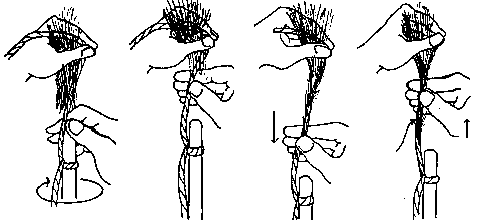
GUILD
33 Haywood Street
Asheville NC
28801
technical help: 828-255-7818
for orders: 1-800-327-8448
fax: 828-255-8593
e-mail us at
inform@earthguild.com
List of Instructions
Catalog
(shopping cart enabled)
Earth Guild Home
See: Drop
Spindles, Spinning Books,
Fibers
SPINNING WITH A DROP SPINDLE
We wore our own skins first, of course. Then the second-hand skins of other creatures. Fig leaves, for a season—but the fashion passed. Cloth has been the preferred covering for the past few thousand years. Before the weaving of cloth, the spinning of fibers. An ancient and mysterious craft.
 |
|
Roving is fiber prepared all the way up to spinning: cleaned and combed straight. Drop spindles are weights that are spun to put in twist. You will hold some roving in one hand, pull a few fibers out, and allow the spinning weight to twist the fibers into yarn. A chop stick stuck into a potato or a twig tied to a rock will make a spindle. Some of the best, finest spinning done was entirely by hand—just fingers, the Incas. And, of course, there are spinning wheels of various designs. But a drop spindle is a good start.
The knack will elude you for a while: a simultaneous coordination of several actions. It's easier than riding a bicycle, for instance. And, you'll never forget how, and will not remember why it was once so difficult.
|
|
 |
|
Pull out a handful of fibers from the roving. Hold in your left hand. Take the end of yarn from the spindle. Lay the end across the fibers, six or eight inches back over your wrist. Hold the end securely and let the spindle dangle down from your left hand. When you spin the spindle, twist accumulates in the held end of yarn; and this twist transfers to the loose fibers as they draw each other into the newborn yarn (note: "hand" here usually means "thumb and forefinger of").
Here we go. Give the spindle a good clockwise twist with right hand. Let it spin, without letting go of the yarn end. Right hand grabs yarn end just before the new fibers start. Let twist accumulate for a few turns. Now right hand tight, loosen left, and pull yarn end through fibers—three of four inches. A few will catch on the old yarn. Left hand tight, slide hand up yarn. Twist travels up, binding old yarn to new fibers.
Again: right hand tight, loosen left and pull some new fibers. Again: right hand tight, loosen left and pull some new fibers; left tight, slide right up, allowing twist to grab new fibers. One hand always holding securely. Left simply loosening and tightening. Right pulling down tight, sliding up loose. Don't let go with both hands. Don't let the spindle reverse—give another twirl as necessary—always clockwise. That's it, the hard part. When the yarn breaks, pick it up and start again. As you work at it, the breaks become less and less frequent. Persistence furthers.
 |
|
And go, as before. All of these motions smooth and speed up with practice.
Eventually, the spindle is too full of yarn to wind on more. Break it off and make a skein. A niddy-noddy is best here—for even tension and for speed. But wrap around a skeiner, or a chair or between your palm and elbow. (You can pull full cones off the spindle intact, save until you have several and do all your skeining at once.) You don't need to wash roving-spun yarn (but wetting, then letting dry under moderate tension helps set the twist). Dye the yarn, weave with it, knit, as you will. It's yours.
You have learned the main thing. Mohair, alpaca, cotton, flax, silk, jute, dog hair—each with it's peculiar tricks. But the door's open.
A good spinner does it all on purpose. Lumps where lumps are intended. Even and smooth to a consistent diameter, thick or thin. Or loops every 3/8 inch. Hand-spun doesn't necessarily mean clumsy and inept. Taste, of course is a personal matter.
 |
Yarn gains strength from plying. A three-ply yarn is stronger than a single-ply yarn of the same diameter. Plying is spinning two or more single yarns together, usually in the opposite direction from which the singles were spun. The countervailing twists lock each other in. If singles are spun clockwise, they're plied counterclockwise. Z-twist and S-twist are other names for clockwise and counterclockwise. |

